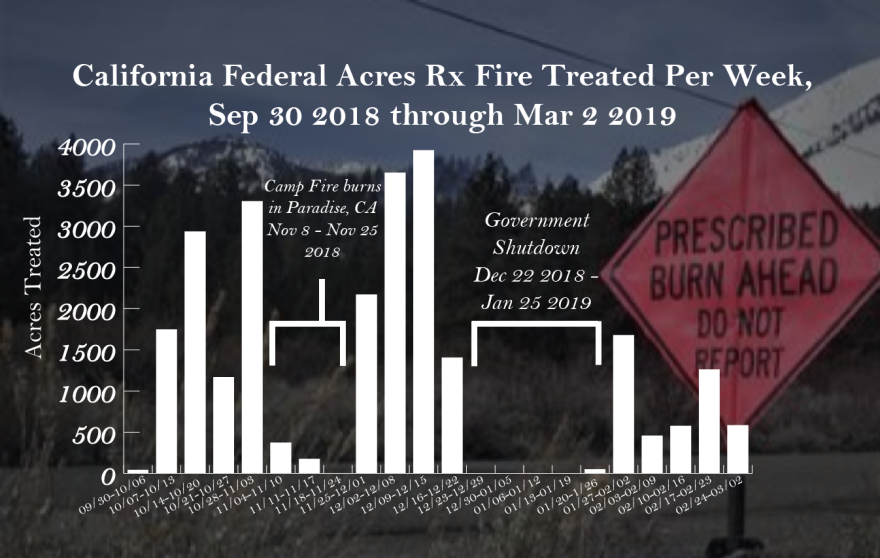The 35-day government shutdown in late December and January halted federal wildfire preparations throughout the country. For the Sierra Nevada, KUNR found that there were key burn opportunities that were missed in that period. In some areas, prescribed burn opportunities won’t happen until later in the spring, because there’s simply too much snow.
KUNR News Director Michelle Billman speaks with Bree Zender, who has spent the past several weeks mining through interagency data to see what kind of effect the shutdown had on the area.
BILLMAN: So, you set out to find out how the shutdown affected prescribed burns. How did you go about doing that?
ZENDER: Well, first, I started talking with some folks at the US Forest Service. You know, go to the source and see what they had to say, but I didn’t really get too far. The media representatives on the national level wouldn’t let the employees really talk about what was going on concerning the shutdown. They could only say, you know, 'We are assessing the situation,' and didn’t point me in any particular direction.
However, the Forest Service works with a lot of other federal, state and local agencies on these treatments, so I tried contacting those people. I ended up talking with some folks from the National Weather Service, at CALFIRE, and at local interagency organizations. Eventually, I was brought to this dataset, displaying all the prescribed burns and other kinds of wildfire prep treatments in California.
BILLMAN: Oh, yes…that dataset. I remember you going through all that. How long did it take you to track all of the information?
ZENDER: I mean, altogether it was probably around, like, 24 hours or so. I was camped out at my desk at work and at home. I had to click on this map on each individual fire. If you didn't know, California is a giant state with a lot of prescribed burns, so I had to look up these treatments one by one and basically make my own dataset.
BILLMAN: Now that you have this information, what do we take away from it?
ZENDER: So, we’ll likely never really know an exact number of acres that were missed in burning because every day is just so up in the air. It’s dependant on the weather, how many workers are available, [etc.]. However, we can track what was happening beforehand, and things were really ramping up beforehand. In just the three weeks before the shutdown, the US Forest Service burned about 9,000 acres throughout California. Things were really ramping up.
Based on the folks that I’ve talked to at the National Weather Service, there were some clear good burning days that they couldn’t burn.
BILLMAN: We’ve talked a lot about the shutdown, but then, right after that, there was a ton of snow in the Tahoe region. What kind of impact did that have?
ZENDER: So, with this historic snowpack, some of the higher elevations received more than 600 inches of snow, but usually for prescribed burns, a bit of snow is a good thing, especially for pile burns, which is one of the main wildfire prep treatments in the mountains. These piles are usually four or five feet tall, and with all the snow, you can’t reach the piles to burn them.
BILLMAN: And now that we have this information from your reporting, and we’re a couple months out from the shutdown, what’s next?
ZENDER: Well, these agencies are doing their best to prepare for the next wildfire season. Local, state and federal fire officials have told me that with the heavy snowpack, there’s going to be a lot of water to feed plants, so there’s going to be more fuel to burn in the upcoming fire season.
However, because it was such a moist winter, there’s going to be more time to do these prescribed burns before the bulk of the wildfire season starts ramping up.
Also, the Tahoe National Forest is now resuming prescribed burns in the Tahoe Basin now that some of the snow has melted, but it's always weather permitting for every burn.
BILLMAN: The government shutdown ended more than two months ago. The news cycle has moved on from it. We’re not hearing a lot of impact stories at this point. Why should we be talking about this?
ZENDER: Well, several lawmakers, including Nevada Senator[s] Jacky Rosen [and Catherine Cortez-Masto, in addition to California Senators Kamala Harris and Dianne Feinstein], signed a letter back in February, saying they’re gravely concerned about the effects on wildfire prep in the West. And we, as the public, haven’t really seen a clear answer on this. Fire season is going to be upon us soon.
As for the state of California, they’re really trying to make up for this. Governor Gavin Newsom has declared a state of emergency, and has called on the National Guard to assist on the work.






